
Climate Change and Food Security

UN Food & Agriculture Organization
FAO
FAO
Disaster Risk Reduction for Food and Nutrition Security regarding global climate change was the focus of the 2011 report with extracts here.
CLIMATE CHANGE AND DISASTER RISKS
Climate change will have profound and far-reaching effects on the environment, ecosystems, natural resources, economy and human life. In relation specifically to disaster risks, climate change is expected to result in more frequent and intensive climate-related hazards. It will magnify existing patterns of disaster risk and present scenarios that surpass the existing capacity of the humanitarian and development communities.
The Fourth Assessment Report of the Intergovernmental Panel on Climate Change indicates that climate change is likely to alter risk patterns in several ways :Increase the frequency and intensity, reduce the predictability and change the spatial distribution of extreme climatic hazards, such as temperature extremes, floods and droughts, heat waves, wild-land fires and storms, with a range of effects in different regions. Some impacts will occur in regions with no history of a given hazard.
Increase the risk and vulnerability of particular social groups and economic sectors as existing vulnerabilities are compounded by climate change-related processes, such as sea level rise, glacier melt and ecosystem stress and degradation of natural resources. The increase in vulnerability will vary by region: regions dependent on subsistence agriculture may be affected by food and water shortages; small island developing states and coastal zones will experience a rise in sea level; regions depending on water from glacier melt for agriculture and human consumption could experience water shortages.
Projected Scenarios for Specific Types of Hazards
Drought
Drought-affected areas will likely become more widely distributed, leading to more widespread water stress, increased risk of water and food shortages and, therefore, malnutrition. Southern Africa, parts of South America, Mexico, the Mediterranean basin and northern China are highly likely to experience harsh drought conditions in the future. In Africa, the areas suitable for agriculture, as well as the length of growing seasons and yield potential, are expected to decrease, particularly along the margins of semi-arid and arid areas. By 2020 yields from rain-fed agriculture could be reduced by up to 50 percent in some African countries, severely compromising agricultural production and access to food.
Floods
It is very likely that heavy precipitation events will become more frequent as a result of climate change. Coastal areas, especially heavily populated megadelta regions in South, East and South-East Asia, will be at the greatest risk due to increased flooding from the sea and, in some mega-deltas, flooding from the rivers.
Tropical cyclones
Higher sea temperatures are likely to lead to more intense tropical and extratropical cyclones. This will directly increase hazard exposure in existing cyclone hotspots, particularly if combined with an increase in the concentration of population and economic activities in these areas. At the same time, higher sea temperatures may also alter cyclone tracks, creating new hotspots exposed to tropical storms that historically have not suffered cyclones.
Glacier melt
The melting of the glaciers will produce water shortages, which are expected to be especially severe in parts of South America and Central Asia. The disappearance of glaciers in the Andes is expected to accelerate, a loss which would threaten nearly 30 million people dependent on the supply of glacial water for agriculture, human water consumption, electricity and livestock production.It is likely that increased glacier melt in the Himalayas will lead to the formation of larger glacier lakes, which are likely to result in increased flooding in many river systems in South Asia. This flooding could cause potentially catastrophic glacial lake outburst floods, rock avalanches from destabilized slopes, overflow floods and natural dam rupture.
Sea level rise
Over 600 million people live in coastal areas that are less than 10 meters above sea level, and two-thirds of the world’s cities with populations over five million are located in these at-risk areas. Sea level rise is likely to produce coastal erosion, wetland and coastal plain flooding, salinization of aquifers and soils, and a loss of habitats for wildlife and plants. Low-lying coastal regions in developing countries such as Bangladesh, China, India and Viet Nam have especially large populations living in at risk coastal areas such as deltas. Another danger for some island nations is the possible loss of fresh-water supplies as sea levels rise and saltwater intrusion pollutes aquifers. Small island states are especially at risk, as sea level rise is expected to exacerbate inundation, storm surge, erosion and other coastal hazards, thus threatening vital infrastructure and settlements that support the livelihood of island communities.
The most severe consequences of climate change will likely be on the food security
and livelihoods of agriculture-dependent populations in vulnerable countries.
Most estimates indicate that climate change is likely to reduce agricultural productivity, production stability and incomes in areas that already experience high levels of food insecurity. Long-term changes in the patterns of temperature and precipitation will shift
production seasons, increase the supply variability and risks in the fishing sector, and contribute to the emergence of new animal and plant diseases − or introduce diseases in places where they formerly did not exist. In addition, changes in temperature and
rainfall can favour outbreaks of insect infestations on forests and timber plantations. Drought, hurricanes, warmer temperatures and shifting winds resulting from climate change will increase the risk and frequency of wildfires.
CLIMATE CHANGE AND DISASTER RISKS
Climate change will have profound and far-reaching effects on the environment, ecosystems, natural resources, economy and human life. In relation specifically to disaster risks, climate change is expected to result in more frequent and intensive climate-related hazards. It will magnify existing patterns of disaster risk and present scenarios that surpass the existing capacity of the humanitarian and development communities.
The Fourth Assessment Report of the Intergovernmental Panel on Climate Change indicates that climate change is likely to alter risk patterns in several ways :Increase the frequency and intensity, reduce the predictability and change the spatial distribution of extreme climatic hazards, such as temperature extremes, floods and droughts, heat waves, wild-land fires and storms, with a range of effects in different regions. Some impacts will occur in regions with no history of a given hazard.
Increase the risk and vulnerability of particular social groups and economic sectors as existing vulnerabilities are compounded by climate change-related processes, such as sea level rise, glacier melt and ecosystem stress and degradation of natural resources. The increase in vulnerability will vary by region: regions dependent on subsistence agriculture may be affected by food and water shortages; small island developing states and coastal zones will experience a rise in sea level; regions depending on water from glacier melt for agriculture and human consumption could experience water shortages.
Projected Scenarios for Specific Types of Hazards
Drought
Drought-affected areas will likely become more widely distributed, leading to more widespread water stress, increased risk of water and food shortages and, therefore, malnutrition. Southern Africa, parts of South America, Mexico, the Mediterranean basin and northern China are highly likely to experience harsh drought conditions in the future. In Africa, the areas suitable for agriculture, as well as the length of growing seasons and yield potential, are expected to decrease, particularly along the margins of semi-arid and arid areas. By 2020 yields from rain-fed agriculture could be reduced by up to 50 percent in some African countries, severely compromising agricultural production and access to food.
Floods
It is very likely that heavy precipitation events will become more frequent as a result of climate change. Coastal areas, especially heavily populated megadelta regions in South, East and South-East Asia, will be at the greatest risk due to increased flooding from the sea and, in some mega-deltas, flooding from the rivers.
Tropical cyclones
Higher sea temperatures are likely to lead to more intense tropical and extratropical cyclones. This will directly increase hazard exposure in existing cyclone hotspots, particularly if combined with an increase in the concentration of population and economic activities in these areas. At the same time, higher sea temperatures may also alter cyclone tracks, creating new hotspots exposed to tropical storms that historically have not suffered cyclones.
Glacier melt
The melting of the glaciers will produce water shortages, which are expected to be especially severe in parts of South America and Central Asia. The disappearance of glaciers in the Andes is expected to accelerate, a loss which would threaten nearly 30 million people dependent on the supply of glacial water for agriculture, human water consumption, electricity and livestock production.It is likely that increased glacier melt in the Himalayas will lead to the formation of larger glacier lakes, which are likely to result in increased flooding in many river systems in South Asia. This flooding could cause potentially catastrophic glacial lake outburst floods, rock avalanches from destabilized slopes, overflow floods and natural dam rupture.
Sea level rise
Over 600 million people live in coastal areas that are less than 10 meters above sea level, and two-thirds of the world’s cities with populations over five million are located in these at-risk areas. Sea level rise is likely to produce coastal erosion, wetland and coastal plain flooding, salinization of aquifers and soils, and a loss of habitats for wildlife and plants. Low-lying coastal regions in developing countries such as Bangladesh, China, India and Viet Nam have especially large populations living in at risk coastal areas such as deltas. Another danger for some island nations is the possible loss of fresh-water supplies as sea levels rise and saltwater intrusion pollutes aquifers. Small island states are especially at risk, as sea level rise is expected to exacerbate inundation, storm surge, erosion and other coastal hazards, thus threatening vital infrastructure and settlements that support the livelihood of island communities.
The most severe consequences of climate change will likely be on the food security
and livelihoods of agriculture-dependent populations in vulnerable countries.
Most estimates indicate that climate change is likely to reduce agricultural productivity, production stability and incomes in areas that already experience high levels of food insecurity. Long-term changes in the patterns of temperature and precipitation will shift
production seasons, increase the supply variability and risks in the fishing sector, and contribute to the emergence of new animal and plant diseases − or introduce diseases in places where they formerly did not exist. In addition, changes in temperature and
rainfall can favour outbreaks of insect infestations on forests and timber plantations. Drought, hurricanes, warmer temperatures and shifting winds resulting from climate change will increase the risk and frequency of wildfires.
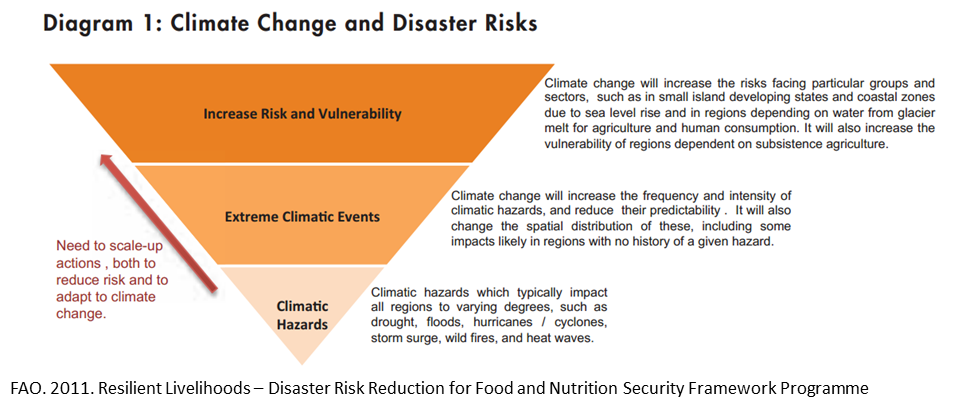
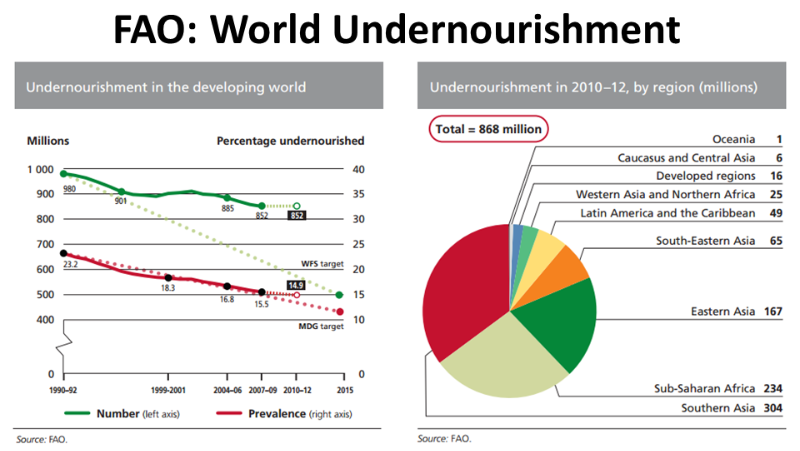
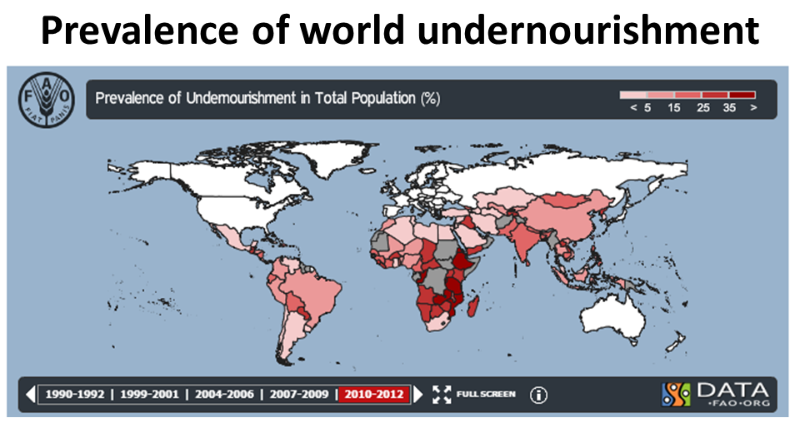
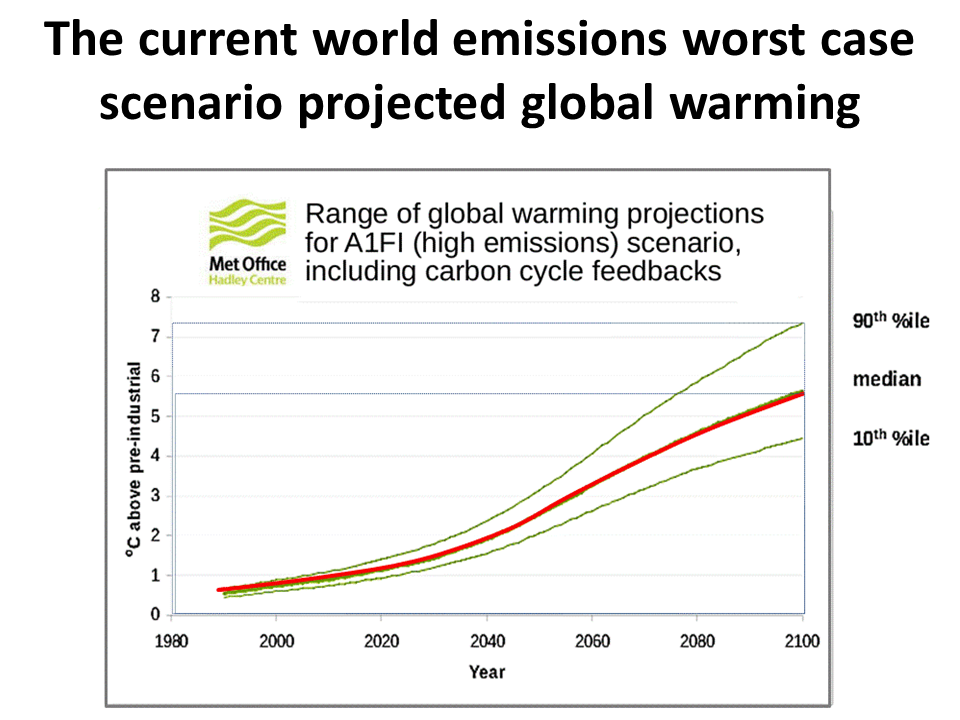
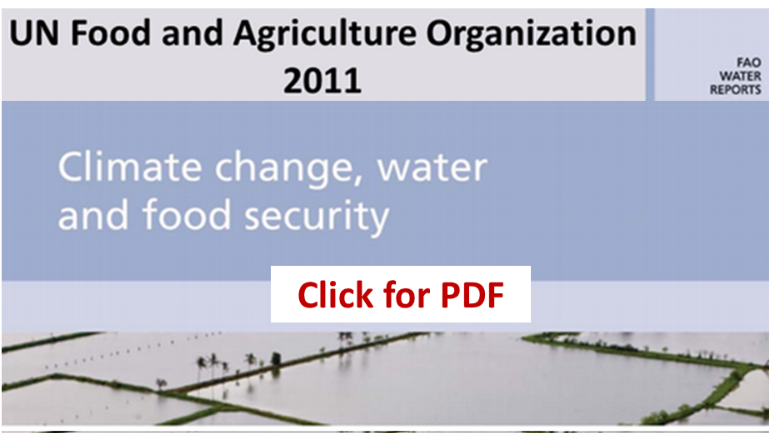
FAO 2013 Resilient Livelihoods- Disaster Risk Reduction
Climate change and disaster risks
Climate change will have profound and far-reaching effects on the environment, ecosystems, natural resources, economy and human life. In relation specifically to disaster risks, climate change is expected to result in more frequent and intensive climate-related hazards. It will magnify existing patterns of disaster risk and present scenarios that surpass the existing capacity of the humanitarian and development communities.
Climate change and disaster risks
Climate change will have profound and far-reaching effects on the environment, ecosystems, natural resources, economy and human life. In relation specifically to disaster risks, climate change is expected to result in more frequent and intensive climate-related hazards. It will magnify existing patterns of disaster risk and present scenarios that surpass the existing capacity of the humanitarian and development communities.
May 2015 FAO The State of Food Insecurity in the World
Double click here to edit this text.
Double click here to edit this text.
Mar 2015 FAO 1st Crop Prospects & Food Situation FAO’s first forecast for global wheat production in 2016 points to a small decrease, with
lower outputs expected in Europe and the United States of America. FAO estimates that, globally,
34 countries, including 27 in Africa, are in need of external assistance for food.Adverse weather reduced 2015 cereal output, resulting in a significant increase in
the number of food insecure people in several countries
lower outputs expected in Europe and the United States of America. FAO estimates that, globally,
34 countries, including 27 in Africa, are in need of external assistance for food.Adverse weather reduced 2015 cereal output, resulting in a significant increase in
the number of food insecure people in several countries